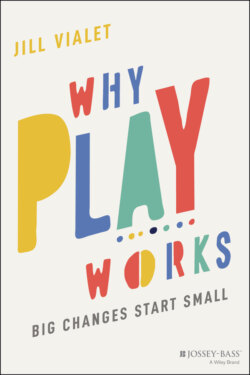Читать книгу Why Play Works - Jill Vialet - Страница 6
Introduction
ОглавлениеIn 1995 I was running a small local nonprofit organization called the Museum of Children's Art (mocha) in Oakland, California. We had a number of partnerships with schools—basically artist residencies—and one of them was with a local school named Santa Fe Elementary where Mrs. Peyton was the principal.
Although much of the world has changed since I was a kid, school offices have not. They are typically busy hives of activity, with a counter that keeps visitors from coming in too deep, two desks for the school secretary and another administrative helper, and an inner sanctum—the principal's office—just off to one side. The Santa Fe office was set up just like this, and I recall sitting in one of the chairs generally reserved for students anticipating punishment up against the front wall, waiting for Mrs. Peyton.
The meeting had been scheduled for just after the lunch hour, and Mrs. Peyton was running late. After about 20 minutes, Mrs. Peyton emerged followed by three little boys. The young men seemed about nine or ten years old, and they all looked absolutely miserable. Mrs. Peyton, in turn, was furious. She ushered the boys to the school secretary, conveyed some instructions about contacting their families and then marched back into her office, stopping briefly to signal that I should follow.
Once in the office, I sat in the chair opposite hers and, before I had fully settled in, Mrs. Peyton launched into the litany of reasons that, basically, recess was hell. The teachers found every reason to be anywhere but the playground, the students didn't know how to get a game going or to keep a game going, the conflicts that arose on the playground followed the students back into the classroom, and, most frustratingly, these same three boys kept getting into trouble. She was building up steam as she went, and the description of the scene that she painted sounded hopeless. But the thing I remember most clearly was when she said, “And the worst part is that, because of recess, these boys are starting to believe that they're bad kids. These are not bad kids.”
I hadn't said anything yet, but I must have nodded or signaled some sort of understanding because Mrs. Peyton took a breath and asked, “Can't you do something? Can you help fix recess?”
Initially, I was taken aback by the question. After all, I was there in her office to talk about the artist residency program. But the question got me thinking, and I immediately flashed on my own childhood growing up in Washington, DC, and afternoons spent at the Macomb Street playground. There was a guy who worked for the DC Parks and Rec Department named Clarence who was responsible for all the assorted activities that happened at the park. Mostly I remember him keeping the center open and coaching various teams—basketball and flag football most distinctly. There was the occasional DC Metro spelling bee that some of the kids participated in, and I think there must have been arts and crafts, but generally speaking we just hung out until it was time to go home for dinner.
It's not insignificant that I so vividly recall the basketball and football. This was the 1970s and Title IX had passed in 1972, so although there was a growing shift in attitudes about making opportunities available to women and girls, from my young perspective, it largely meant that I got to play with the boys.
When Mrs. Peyton asked if I might “do something,” my immediate thought was how Clarence had always made sure that I got in the game. I was a good athlete and although Clarence didn't make it a big deal, I had a vague sense that he had preemptively squashed any resistance that might have arisen to my participation as a girl. And so, when Mrs. Peyton asked, “Can't you do something? Can you help fix recess?” the first thing I thought was: I could make it possible for every kid to have a Clarence.
That was 25 years ago. Since then I've learned a lot about how to make it possible for kids “to have a Clarence.” I've also learned a lot about the power of play, especially when someone like Clarence is making it accessible. The organization I founded back in 1996, originally called Sports4Kids and now called Playworks, works through direct service and more indirectly through training and online support. Our original model, which we now refer to as Coach, involves a full‐time staffperson (the Clarence) placed at an elementary school and overseeing four main components: Recess, Class Gametime, the Junior Coach Leadership Program, and Leagues. We'll go a little more into each of these, but here's a little context.
